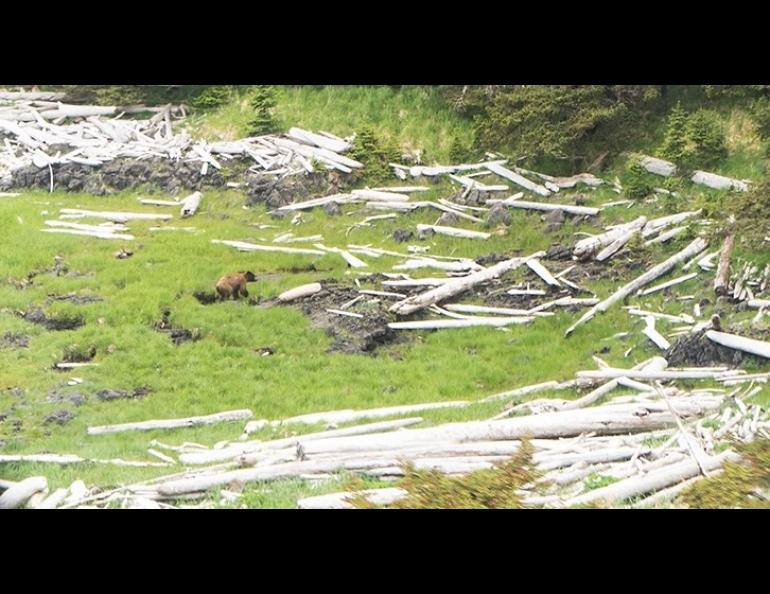The first volcano scientists of an international team deposited on a Southeast Alaska island by helicopter Sunday quickly learned they had an unwanted presence to contend with.
A brown bear.
And this one wouldn’t move from its position about 100 yards from the beach site where the scientists and their instruments were gathered.
“We were just chatting and waiting for the others to get here,” said Claire Puleio, a Ph.D. volcanology student doing research through the University of Alaska Fairbanks Geophysical Institute.
Puleio and fellow UAF Ph.D. volcanology student Valerie Wasser were the first pair from the eight-person team of six scientists and two UAF science communications staff to be flown to the island for their research into the inner workings of the reawakened Mt. Edgecumbe volcano.
“And when the second helicopter was coming in with the second group of people, we got the radio call from the pilot who said, ‘There’s a bear really close to you. Kind of around the corner. I think like maybe 100 yards away, pretty close,’ which we didn’t know,” Puleio said.
The incoming helicopter, flown by pilot Tarek Husevold, was carrying the second pair of scientists. All three on the helicopter saw the bear.
“We all made visual contact on it, and then we doubled back around and tried to scare it into the woods,” Husevold said. “It ran back in and didn't go very far. It hid behind a bush and just hung out.”
“We came back a few times to see if we could get him to go into the woods a little further,” he said. “But he just kept hiding behind that bush.”
The helicopter dropped the next two scientists, for a total of four on the ground. Two more, plus the Geophysical Institute’s two-person information team, were at Sitka awaiting their turn.
The third flight carried project principal investigator Társilo Girona and another scientist. Girona is a research assistant professor at the UAF Geophysical Institute
“In that flight, the pilot realized that the bear was getting closer and closer to the landing spot where the others were, instead of the opposite,” Girona said. “That was the really scary thing and is what made me decide to move everyone.”
“The decision process was intense,” he said. “The pilot was concerned because the bear moved quite a bit toward the team with respect to the previous flight. He told me: ‘You decide what you want to do with your team.’”
With adrenaline and awareness running high, Girona decided to have the team pack up and make a short helicopter hop to another of the predetermined study sites.
“My concern was for the safety of everyone,” he said. “So I made the decision to move.”
The encounter was new for Husevold, who has been flying for 15 years.
“This is actually the closest one I've ever seen,” he said.
About 1,000 brown bears inhabit Kruzof and Baranof islands combined, according to the Alaska Department of Fish and Game. The department considers the two islands as a single management area. The islands have no black bears.
The science team underwent bear awareness training before heading to Sitka. Each team member carried bear deterrents.
The science team includes researchers from UAF, the University of Perugia in Italy and University of Alicante in Spain.
Mt. Edgecumbe volcano last erupted about 800 years ago and had been dormant until last year, when it began exhibiting seismic activity and showing some ground deformation.
The science team is focusing on carbon dioxide and heat emitted through the soil and taking carbon dioxide samples for later analysis. Volcanoes emit mostly water vapor, carbon dioxide and sulfur dioxide.
Information gained during the weeklong field campaign will help the researchers form a better idea of how the volcano is behaving.

